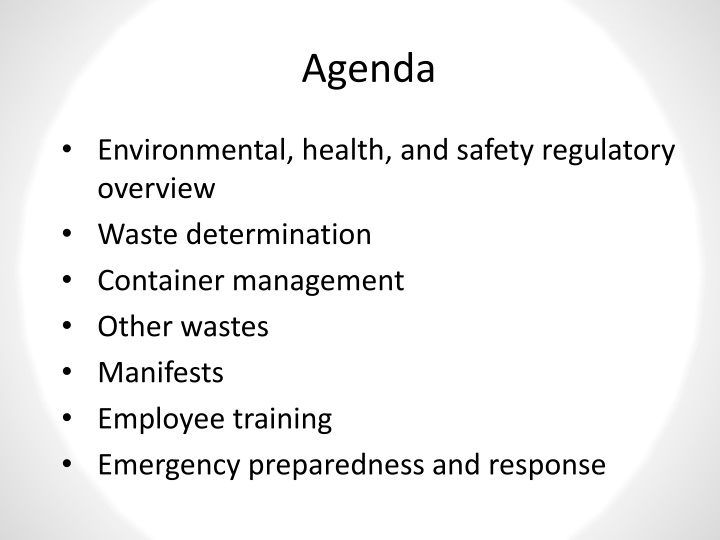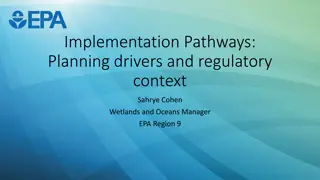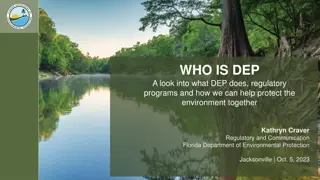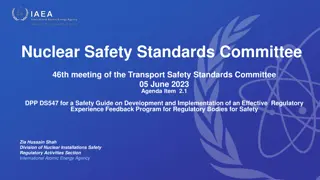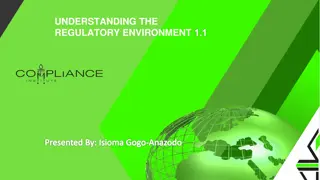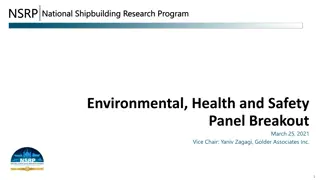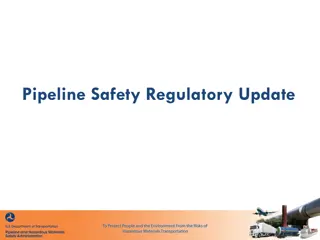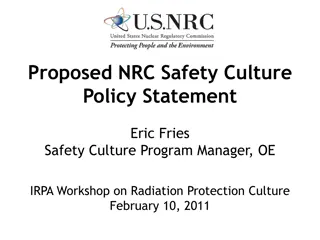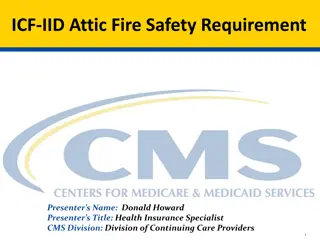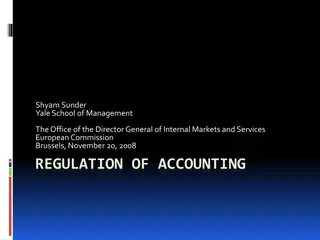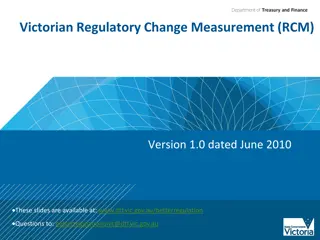Comprehensive Environmental and Safety Regulatory Overview
Comprehensive discussion on environmental, health, and safety regulations, waste determination, container management, employee training, emergency preparedness, and response. Covers topics such as RCRA, wastewater pretreatment, pollution prevention, and major environmental laws like RCRA, OSHA, TSCA, and more. Examines the role of ODEQ and EPA in managing hazardous waste programs in Oklahoma, along with the involvement of other state agencies. Details ODEQ divisions and programs, including those in Land Protection, Water Quality, and Air Quality.
Download Presentation

Please find below an Image/Link to download the presentation.
The content on the website is provided AS IS for your information and personal use only. It may not be sold, licensed, or shared on other websites without obtaining consent from the author.If you encounter any issues during the download, it is possible that the publisher has removed the file from their server.
You are allowed to download the files provided on this website for personal or commercial use, subject to the condition that they are used lawfully. All files are the property of their respective owners.
The content on the website is provided AS IS for your information and personal use only. It may not be sold, licensed, or shared on other websites without obtaining consent from the author.
E N D
Presentation Transcript
Agenda Environmental, health, and safety regulatory overview Waste determination Container management Other wastes Manifests Employee training Emergency preparedness and response
Agenda Q&A session (RCRA) Wastewater pretreatment Pollution prevention Overview of the small quantity generator self-certification program Q&A (all presenters) Wrap up
Context RCRA and other environmental and safety laws ODEQ and EPA ODEQ and other state agencies In Oklahoma RCRA and other programs at ODEQ
Major Environmental and Safety Laws Resource Conservation and Recovery Act (RCRA) Occupational Safety and Health Act (OSHA) Toxic Substances Control Act (TSCA) Comprehensive Environmental Response, Compensation Liability Act (CERCLA/Superfund) Safe Drinking Water Act (SDWA)
Major Environmental and Safety Laws Federal Insecticide, Fungicide, and Rodenticide Act (FIFRA) Clean Air Act (CAA) Clean Water Act (CWA) Atomic Energy Act (AEA) Hazardous Materials Transportation Act (HMTA)
ODEQ and EPA ODEQ is authorized by EPA to manage the hazardous waste regulatory program in the state of Oklahoma
ODEQ and Other State Agencies Oklahoma Corporation Commission Oklahoma Department of Transportation Oklahoma Department of Health Oklahoma Department of Mines Oklahoma Water Resources Board Oklahoma Conservation Commission Oklahoma Department of Wildlife
RCRA and Other Programs at DEQ ODEQ Divisions Land Protection Division Water Quality Division Air Quality Division Environmental Complaints and Local Services Division State Environmental Laboratory Services Administrative Services Division
Programs in the Land Protection Division at ODEQ Inspection/Permitting Hazardous Waste Compliance and Inspection Section SQG Self-Certification Program Hazardous Waste Permitting and Corrective Action Section Radiation Management Section Solid Waste Compliance and Inspection Section Tire Recycling Program Underground Injection Control Unit
Programs in the Land Protection Division at ODEQ Cleanup/Remediation Brownfields Program Land Restoration Section Site Cleanup Assistance (SCAP) & Armory Cleanup Program Superfund Site Remediation Section Tar Creek Section Voluntary Cleanup Program
Programs in the Land Protection Division at ODEQ Assistance Risk Management Section Solid Waste Planning and Sustainability Unit (SQG Self-Certification Program)
Waste Determination Waste determination: Determining if a material meets the definition of a hazardous waste
Two Types of Hazardous Waste Characteristic waste Listed waste
Hazardous Waste Determination Process Step 1: Is the material a solid waste? Step 2: Is the waste excluded? Step 3: Is the waste a listed waste? Step 4: Is the waste a characteristic waste?
Characteristic Hazardous Wastes Ignitability (D001) Corrosivity (D002) Reactivity (D003) Toxicity (D004-D043)
Characteristic of Ignitability Applies to: Liquids Solids Ignitable compressed gases Oxidizers
Ignitable Liquid A liquid that has a flash point <140 F (60 C)
How Do You Know If the Material Is a Liquid? Knowledge Paint Filter Liquids Test Pressure Filtration Technique
How Is the Flash Point Determined? A test flame is applied to fumes/vapors given off by the sample Pensky-Martens Closed-Cup Setaflash Closed-Cup
Alcohol-Content Exclusion Aqueous solution Contains <24% alcohol (by volume)
How Do You Know if a Liquid Waste Is Aqueous? It contains at least 50% water (by weight)*
Ignitable Solid Material is capable of ignition through: Friction Moisture absorption Spontaneous ignition Material must burn so vigorously and persistently that it creates a hazard
Ignitable Compressed Gas Flammable when in a mixture of 13% or less with air Has a flammable range with air of more than 12%
Oxidizer Material that yields oxygen readily to stimulate the combustion of organic matter Nitrates, permanganates, chlorates, and peroxide (organic and inorganic) are examples
Characteristic of Corrosivity aqueous waste with a pH <2.0 or > 12.5, acids or bases liquid waste that corrodes carbon steel at a rate of >0.25 inch (6.35 mm) per year
How do you know if the Waste Is aqueous? The material must contain at least 20% free water by volume* *The definition of aqueous is different when determining the pH of a waste versus evaluating the applicability of the alcohol-content exclusion (where the alcohol must contain at least 50% water by weight).
How do you know if the Waste is a liquid? Exactly the same process used for ignitable wastes: Knowledge Paint Filter Liquids Test Pressure Filtration Technique
How Do You Know If You Have a Corrosive Solid TRICK QUESTION: There are no corrosive solids at the federal Level
Characteristic of Reactivity Normally unstable and readily undergoes violent change without detonating Reacts violently with water, i.e. elemental sodium or potassium Forms potentially explosive mixtures with water
Characteristic of Reactivity Generates toxic gases, vapors, or fumes in quantities sufficient to present a danger to human health or the environment when mixed with water Cyanide or sulfide-bearing waste that generates toxic gases, vapors, or fumes in a quantity sufficient to present a danger to human health or the environment when exposed to conditions in which the pH is between 2.0 and 12.5
Characteristic of Reactivity Capable of detonation or explosive reaction if subjected to a strong initiating source or if heated under confinement Is readily capable of detonation or explosive decomposition or reaction at standard temperature and pressure Forbidden explosive (as defined by DOT)
Examples of Reactive Wastes Cyanides Lithium-containing materials Sodium containing materials Sulfides Aluminum alkyls Acetyl chloride Chromic acid Hypochlorites perchlorates
Characteristic of Toxicity Developed to protect groundwater Includes: 8 heavy metals arsenic, barium, cadmium, chromium, lead, mercury, selenium, silver 6 pesticides 26 solvents or other organic chemicals
Toxicity Characteristic Leaching Procedure (TCLP) Designed to simulate acidic conditions found in a municipal landfill Extraction Procedure (EP) Toxicity Test was used prior to 1990
TCLP Things to Keep in Mind Reproducibility Cost Oily wastes and organic liquids
Alternatives to Using the TCLP Process knowledge Total waste analysis 20 times rule Directly analyze liquid wastes for total concentration of toxic constituents Wastes that contain less than 0.5% filterable solids The waste is already in liquid form - no extraction is necessary
Listed Wastes F-List: Process wastes not industry specific K-List: Process wastes industry specific P and U-Lists: Discarded unused chemicals
Hazard Codes Indicate the basis on which EPA listed a particular waste Ignitable waste (I) Corrosive waste (C) Reactive waste (R) Toxicity characteristic waste (E) Acute hazardous waste (H) Toxic waste (T)
ICR-Listed Wastes Wastes That Are listed ONLY because they exhibit the characteristic of ignitability, corrosivity, and/or reactivity 29 wastes meet this description The ICR listing does not apply if the waste does not exhibit the associated characteristic at the point of generation
F-Listed Wastes Spent solvents (F001-F005) Electroplating and other metal finishing wastes (F006-F019) Dioxin-containing wastes (F020-F023 and F026-F028) Chlorinated aliphatic hydrocarbon production wastes (F024 and F025)
F-Listed Wastes Wood preserving wastes (F032, F034, and F035) Petroleum refinery wastewater treatment sludges (F037 and F038) Multisource leachate (F039)
Spent Solvents Used for its solvent properties Too contaminated for further use (i.e. spent) Meets a specific before-use concentration
F001 Halogenated solvents Used in large-scale industrial degreasing operations Includes five specific chemicals and one class of compounds
F001 Solvents Carbon tetrachloride Methylene chloride Tetrachloroethylene (perchloroethylene) 1,1,1-trichloroethane Trichloroethylene Chlorinated fluorocarbons
F002 Halogenated solvents Used in small-scale degreasing operations Includes 9 specific chemicals
F002 Solvents Chlorobenzene o-dichlorobenzene Methylene chloride Tetrachloroethylene (perchloroethylene) 1,1,1-trichloroethane 1,1,2-trichloroethane 1,1,2-trichloro-1,2,2-trifluoromethane Trichloroethylene Trichlorofluoromethane
What is the Difference Between F001 and F002 Solvents? Four solvents appear on both lists: Methylene chloride Tetrachloroethylene (perchloroethylene or perc ) Trichloroethylene 1,1,1-trichloroethane
How Do You Know Which Waste Code to Use? F001: used in large-scale industrial degreasing operations cold cleaning vapor degreasing (open top or conveyorized) F002: used in small scale degreasing operations equipment maintenance or repair dry cleaning
F003 Non-halogenated solvents Includes 9 specific chemicals A waste solvent does not carry the F003 listing if it Is not ignitable Listed only because of the characteristic of ignitability (I)
F003 Solvents Acetone n-butyl alcohol Cyclohexanone Ethyl acetate Ethyl benzene Ethyl ether Methanol Methyl isobutyl ketone xylene
